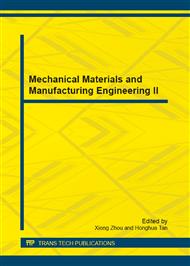p.379
p.387
p.391
p.395
p.402
p.408
p.413
p.422
p.426
A Logistics Model of Total Life Cycle of Mechanical Products
Abstract:
A kind of processing strategy of total life cycle of mechanical products was designed. A logistics model of total life cycle of mechanical products was established based on eight typical states of life cycle of mechanical products. The logistics analysis of total life cycle of a sort of aero-engine was carried out by using the model. The dynamic equivalent quantity of the aero-engines in different states of life cycle was obtained when times changed from the products were first put into production to the time when stable production capacity was reached. The model can also be used to predict logistics of other products rapidly. The results give references for production departments or enterprises which use life cycle methods to configure their production resources effectively and optimize production processes, and also provide a basis for further analysis of total life cycle analysis such as economic and environmental assessment.
Info:
Periodical:
Pages:
402-407
Citation:
Online since:
December 2012
Authors:
Keywords:
Price:
Сopyright:
© 2013 Trans Tech Publications Ltd. All Rights Reserved
Share:
Citation:


